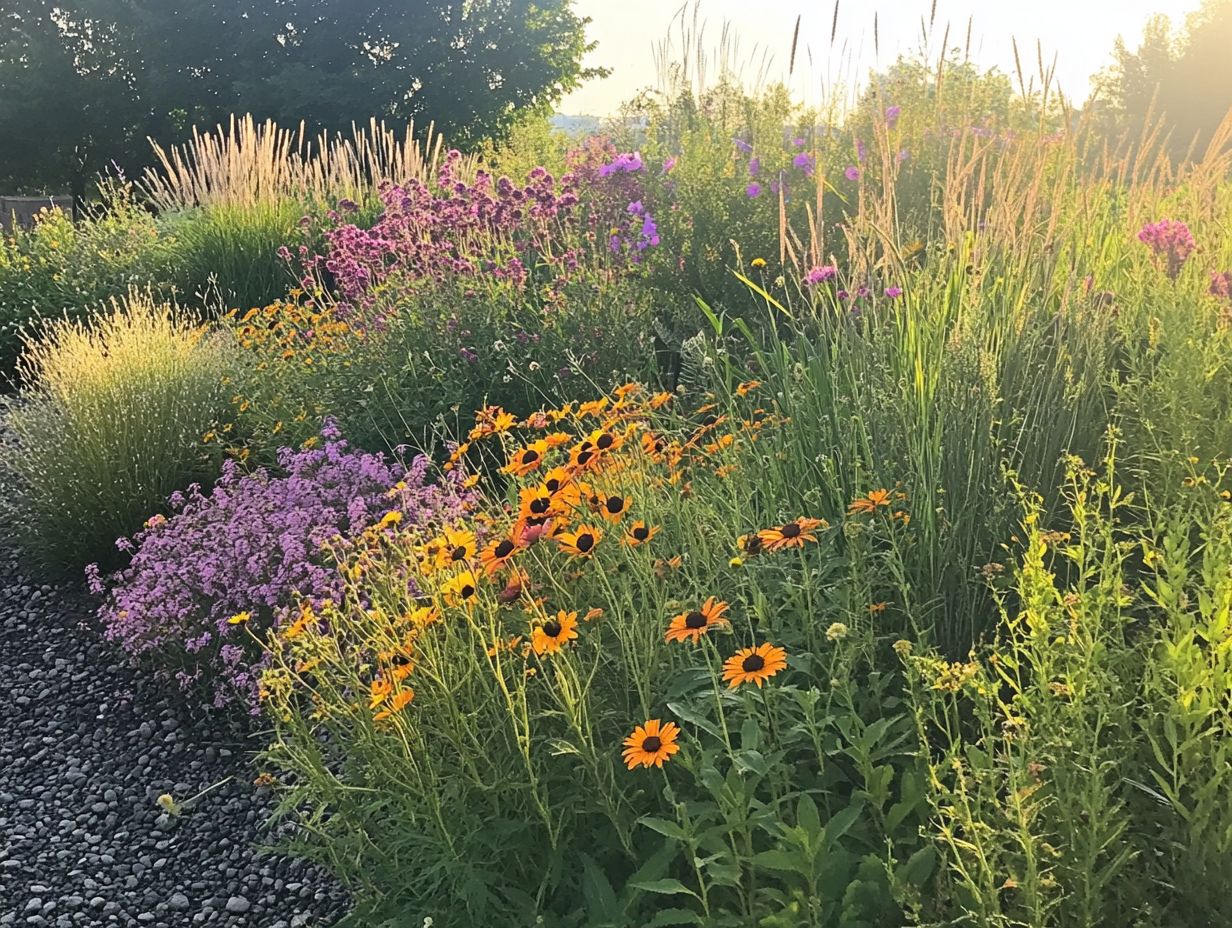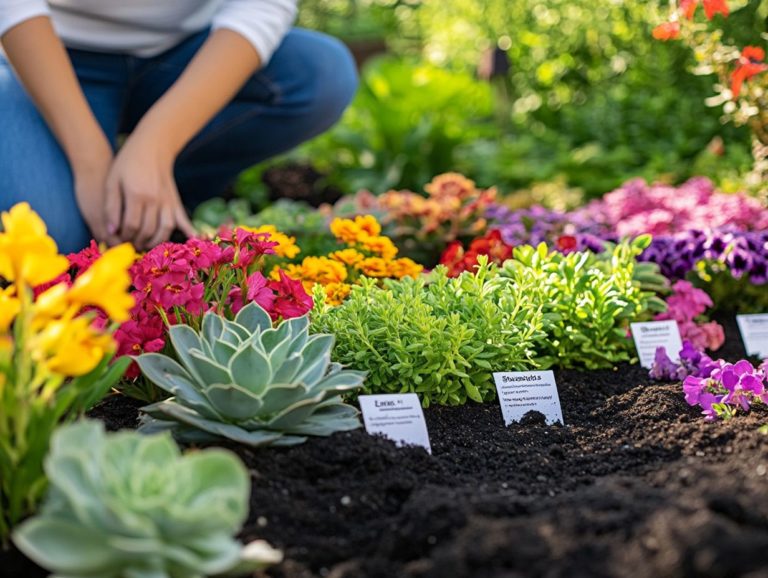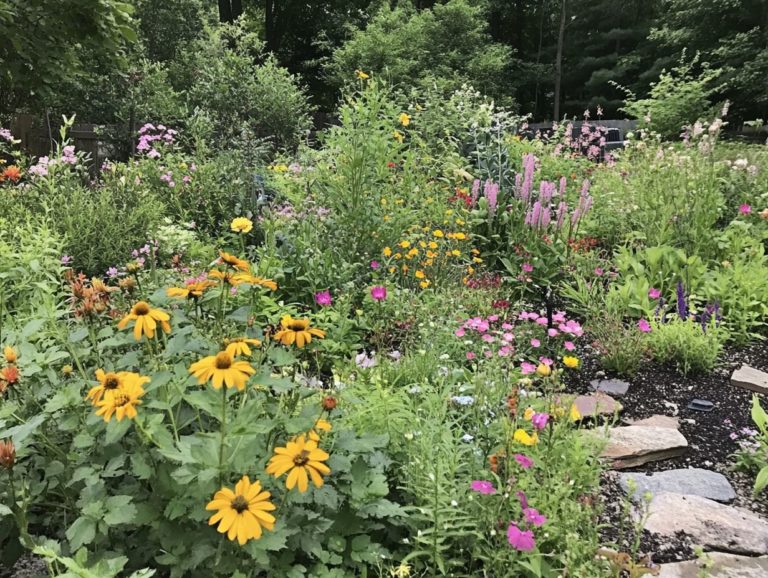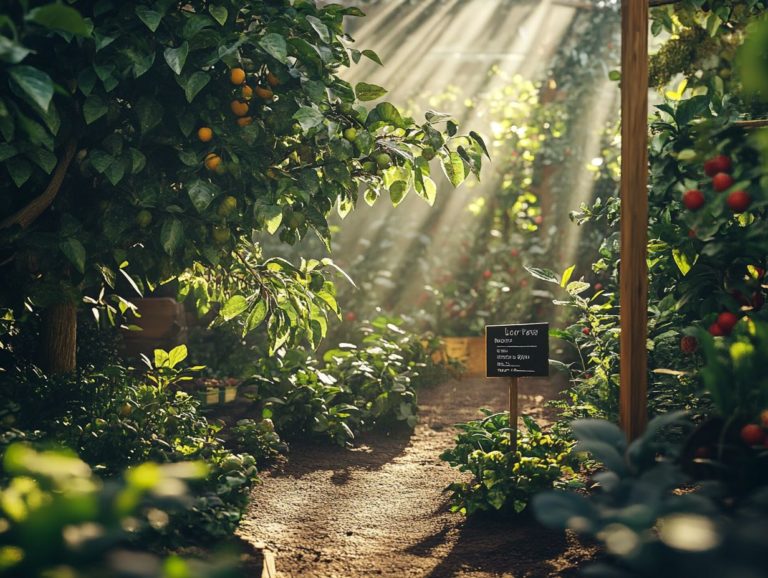“How to Choose Plants for a Rain Garden”
Rain gardens are more than just stunning features in your landscape; they are essential for managing water that flows off surfaces during rain and promoting a variety of different plants and animals.
Let s dive into how you can create a beautiful rain garden! This guide will help you grasp its purpose and choose the right plants for success.
Uncover the environmental and aesthetic advantages, along with crucial considerations for plant selection and practical maintenance tips that will allow your garden to thrive.
Elevate your outdoor space into a sustainable oasis!
Contents
Key Takeaways:

- Consider important things like the type of soil and how well it drains when choosing plants for a rain garden.
- Native plants are generally better suited for rain gardens and require less maintenance.
- Regular care and maintenance are crucial for the long-term success of a rain garden.
What is a Rain Garden?
A rain garden serves as a sophisticated, eco-friendly landscape feature tailored to manage and absorb water that flows off surfaces during rain from impervious structures like roofs, driveways, and roads.
By integrating a diverse selection of garden plants, including native wildflowers and vibrant blooms, rain gardens significantly enhance local water quality, provide essential habitats for wildlife, and elevate the aesthetic charm of your property.
This sustainable gardening approach not only benefits the environment but also fosters a variety of different plants and animals and helps to mitigate the effects of urbanization across various landscapes.
Embracing a rain garden contributes to a healthier ecosystem while adding a touch of natural beauty to your surroundings.
Benefits of a Rain Garden
Rain gardens present a wealth of environmental and aesthetic benefits, positioning them as an invaluable enhancement for both residential and commercial landscapes. They skillfully capture and filter stormwater, aiding in groundwater replenishment while mitigating the risks of flooding and erosion.
Incorporating native wildflowers and vibrant blooms into these gardens elevates biodiversity, drawing in pollinators such as bees and butterflies and enriching the overall health of the ecosystem.
Factors to Consider Before Choosing Plants
Before you select plants for your rain garden, it s essential to consider a few important things, like the type of soil and how well it drains, along with the local climate and sunlight conditions. By understanding these elements, you can ensure that the plants you choose will thrive in their environment, resulting in a sustainable and low-maintenance landscape that effectively manages stormwater.
For instance, some plants have specific soil and light requirements that are crucial for their success, contributing to the overall health and beauty of your garden.
Soil Type and Drainage
Soil type and drainage are important when designing a rain garden, as they directly impact how effectively the garden handles wet conditions. Different soil types like sandy, clay, or loamy come with their own drainage capacities, which can either support or hinder plant health and water absorption.
To accurately assess soil type and drainage, you can perform straightforward tests, such as the jar test to determine soil composition or the percolation test to evaluate drainage capabilities. Amending the soil is crucial, whether you re looking to improve aeration in clay-heavy compositions or enhance moisture retention in sandy varieties.
These factors take on even greater significance in the context of a rain garden, where wet conditions are the norm. Appropriate soil amendments can significantly influence your plant selection. By understanding the specific needs of various plants especially native species that flourish in saturated environments you can ensure your garden is not just functional but truly thriving.
Understanding Climate and Sunlight

Understanding the local climate and sunlight exposure is crucial when selecting the right plants for your rain garden. These elements directly influence plant growth and survival. Different native and garden plants have a range of sunlight needs from full sun to partial shade. This can significantly impact their performance in the rain garden ecosystem.
By assessing these factors, you can create a thriving and sustainable landscape that caters to the unique needs of each plant. It’s essential to consider variables like temperature, humidity, and seasonal changes when curating your selection. For example, a plant that flourishes in a warm, humid climate may struggle in a cooler, drier one.
Choosing species that are well-adapted to your specific environment is key. Opting for native plants not only enhances the beauty of your garden but also supports local wildlife. These species are typically more resilient and better suited to the conditions around you. By aligning your plant choices with both light requirements and climatic nuances, you can cultivate a more harmonious ecosystem.
Types of Plants Suitable for Rain Gardens
When selecting plants for your rain garden, it s essential to understand which types flourish in these unique environments. Consider both native and non-native varieties, as well as the differences between perennial and annual plants.
Native plants generally adapt better to local climate and soil conditions. This makes them a superb choice for sustainable gardening. Meanwhile, non-native plants can add vibrant colors and diversity to the mix. By understanding these categories, you ll be well-equipped to create a rain garden that is balanced, visually captivating, and effective in managing stormwater.
Native Plants vs. Non-Native Plants
Choosing between native and non-native plants for your rain garden can significantly influence its ecological balance and overall success. Native plants are perfectly adapted to your local environment, making them resilient and supportive of local wildlife.
Non-native plants might add a unique flair to your garden, but they often require more care and resources. A carefully considered blend of both can result in a vibrant and sustainable landscape that boosts biodiversity and effectively manages stormwater.
It’s essential to grasp the ecological repercussions of your choices. Native species typically thrive without excessive irrigation or fertilizers, promoting soil health and minimizing maintenance efforts. In contrast, non-natives can introduce competitive behaviors that may disrupt local ecosystems.
While native plants provide vital habitats for pollinators and other wildlife, non-natives offer visual diversity and seasonal interest. Your decision should strike a balance between ecological benefits and personal preferences, ensuring your rain garden enhances your space while fostering a flourishing ecosystem.
Perennials vs. Annuals
The decision between perennial and annual plants shapes both the design and upkeep of your rain garden. This influences its seasonal allure and overall longevity. Perennials, returning year after year, lay a stable foundation for your garden.
Annuals inject vibrant splashes of color that evolve with each season. By thoughtfully combining these two plant types, you can craft a dynamic and visually captivating landscape that flourishes under various conditions.
Perennials typically develop deeper root systems, enhancing soil structure and water retention. This is particularly advantageous for the ecosystem of your rain garden. Once established, these plants generally demand less maintenance, allowing you to enjoy their beauty without the burden of constant care.
Conversely, annuals provide flexibility, inviting you to explore a myriad of color palettes and textures each year. Their shorter life cycle allows them to adapt rapidly to changing conditions, ensuring your garden always has an element of surprise.
The harmonious interplay between these plant types elevates the aesthetic charm of your rain garden while supporting local wildlife and pollinators, enriching your entire gardening experience. Start planning your rain garden today and watch the beauty flourish!
Choosing the Right Plants for Your Rain Garden
Selecting the ideal plants for your rain garden requires carefully selecting plants based on their environment, promoting optimal growth and sustainable stormwater management.
Consider critical factors such as soil type, drainage, sunlight, and climate when choosing your garden plants. Doing so will elevate both the functionality and aesthetic appeal of your garden.
By thoughtfully curating plants that flourish in these specific conditions, you can cultivate a resilient and effective rain garden that enhances both your landscape and the environment.
Matching Plants to Environmental Conditions

Successfully matching plants to their environmental conditions is crucial for creating a thriving rain garden, as it directly influences plant health and stormwater management. Each plant species has specific requirements regarding soil type, moisture levels, and sunlight exposure. Understanding these needs before planting is essential.
Start by examining the sunlight exposure in your garden. Areas with full sun may be ideal for sun-loving perennials like coneflowers or black-eyed Susans, while shaded spots could be better suited for ferns and hostas.
Soil permeability is another critical factor. Plants like sedges love wet, clay-like soil, whereas lavender thrives in well-drained, sandy soil. Choose wisely based on these needs.
Don t forget to consider the moisture retention capabilities. Native species like bee balm can thrive in moderately moist areas, making them perfect for rain gardens.
By thoughtfully analyzing these conditions, you can establish a diverse and robust ecosystem that not only manages water effectively but also adds beauty and provides habitat for wildlife.
Maintaining Your Rain Garden
Maintaining your rain garden is crucial for its long-term success and effectiveness in managing stormwater runoff. Proper care entails regularly monitoring the plants, managing weeds, and ensuring that soil moisture levels are adequate to support the diverse array of native and garden plants you’ve selected for your landscape.
Don t wait! Start maintaining your rain garden today for a thriving ecosystem!
By dedicating time and effort to this upkeep, you not only reap the ecological benefits but also enhance the beauty of your property.
Proper Care and Maintenance for Long-Term Success
Proper care and maintenance are crucial for your rain garden’s long-term success, especially since seasonal changes can significantly affect plant health and performance. Engaging in regular tasks like pruning, deadheading, and checking for pests is essential to keep your garden vibrant and functional.
By understanding the specific needs of the plants in your rain garden, you can implement tailored care strategies that foster resilience and beauty throughout the seasons.
In spring, take a moment to assess the thawing soil and ensure proper drainage; this foundational step is vital for healthy root development. Regular mulching will serve you well by retaining moisture and suppressing weeds, ultimately leading to a healthier ecosystem.
As summer approaches, keep an eye on water levels, particularly during dry spells, since many native plants thrive in well-drained conditions.
When fall arrives, don t forget to remove debris and spent foliage. This not only paves the way for new growth but also helps prevent pest infestations. Remove foliage from pest-attractive plants like elephant ear.
And as winter sets in, consider protecting sensitive species with mulch or protective coverings to ensure they flourish come spring.
Common Challenges in Rain Garden Design
While rain gardens provide a wealth of benefits, they can also pose certain challenges in design and maintenance that may impact their overall effectiveness. Challenges such as poor plant selection, inadequate drainage, and debris buildup can hurt the garden s efficiency, particularly when incorporating plants like elderberry black and summersweet vanilla.
Identify and tackle these challenges head-on to ensure your rain garden thrives! By addressing them proactively, you can secure the long-term success of your rain garden, enhancing both its ecological value and visual appeal.
Dealing with Weeds and Pests
Managing weeds and pests is essential for maintaining a vibrant rain garden. These unwelcome guests can disrupt the delicate ecosystem and compromise plant health. Implement effective maintenance strategies like mulching, regular monitoring, and using natural pest control methods. This way, you can manage weed and pest populations while preserving the garden’s biodiversity.
Proactively addressing these challenges allows you to create a thriving, sustainable environment that continues to fulfill its purpose.
Consider techniques like companion planting, which means growing different plants close together for mutual benefits. Certain plants naturally deter unwanted pests while thriving alongside others. Incorporating beneficial insects, such as ladybugs and lacewings, offers a natural form of pest control and minimizes the need for chemical interventions.
Weed regularly, especially after rain! This stops invasive species from taking over and keeps your garden vibrant. Maintaining proper soil moisture and drainage is crucial, as it encourages healthy plant growth, making them more resistant to infestations that threaten the garden’s ecosystem.
Frequently Asked Questions

What is a rain garden?
A rain garden is a garden designed to capture and absorb rainwater runoff from hard surfaces, such as roofs, driveways, and sidewalks. It helps to reduce erosion, filter pollutants, and replenish groundwater.
Why should I choose plants specifically for a rain garden?
Plants chosen for a rain garden are able to thrive in both wet and dry conditions, making them ideal for managing rainwater runoff. They also provide important ecological benefits, such as supporting pollinators and improving water quality.
How do I choose the right location for a rain garden?
The ideal location for a rain garden is in a low-lying area where water naturally collects, such as at the base of a slope or near a downspout. It should also be at least 10 feet away from your home’s foundation to avoid any potential flooding.
What types of plants should I choose for a rain garden?
Native plants are the best choice for a rain garden because they are well-adapted to the local climate and soil conditions. Look for plants with deep root systems, as they are more effective at absorbing excess water.
How many plants should I include in my rain garden?
The number of plants you need depends on the size of your rain garden. As a general rule, plan for one plant per square foot of surface area. Be sure to consider the mature size of the plants and give them enough space to grow.
Are there any plants I should avoid for a rain garden?
Avoid planting invasive species in your rain garden, as they can quickly take over and crowd out native plants. Also, be cautious of planting trees and shrubs with shallow root systems, as they may not be effective at absorbing excess water.






